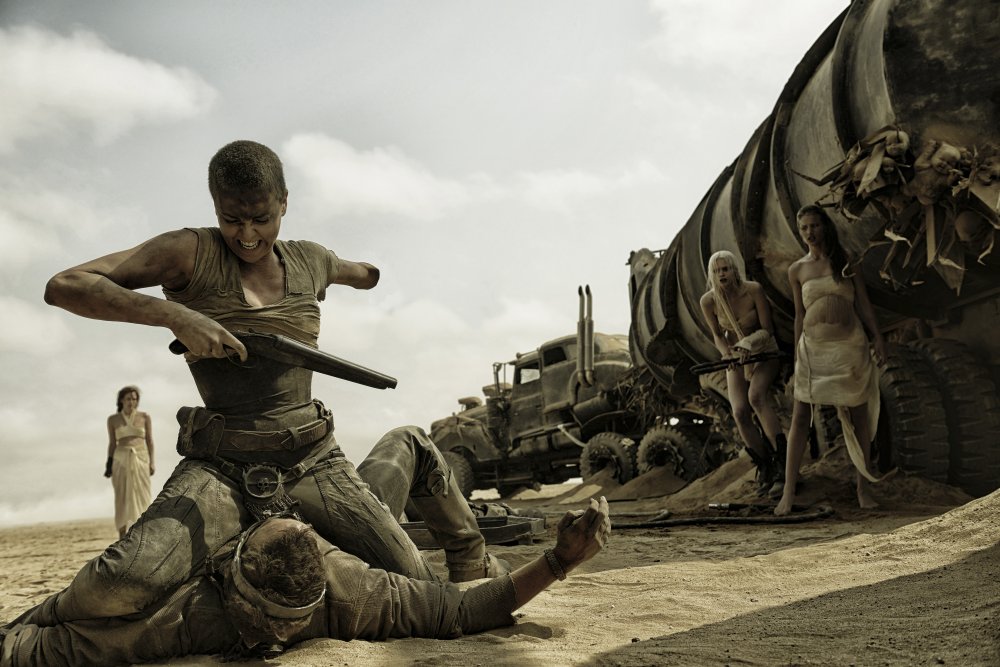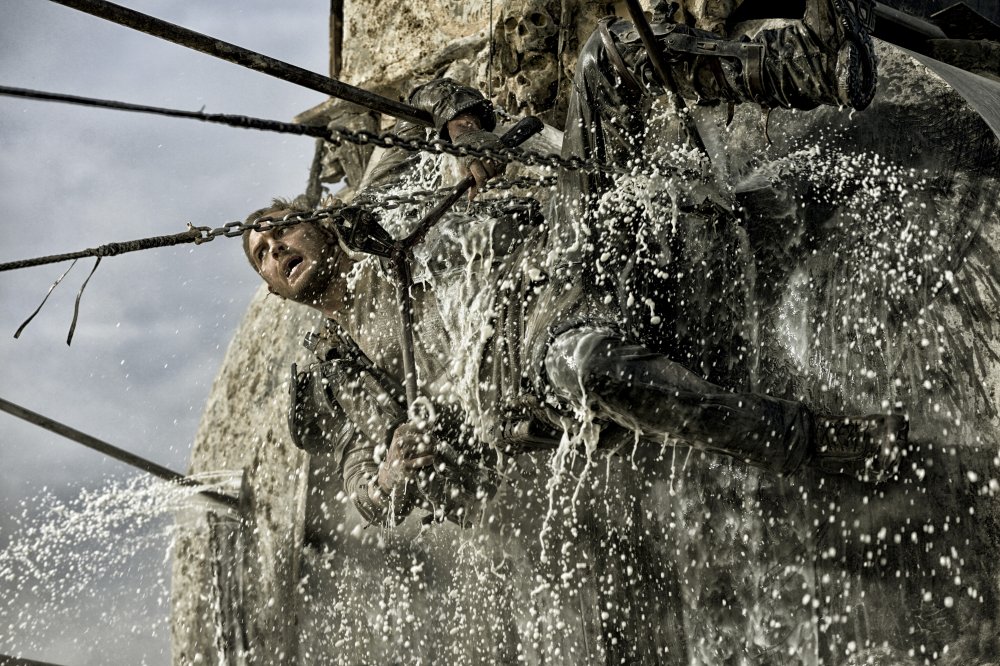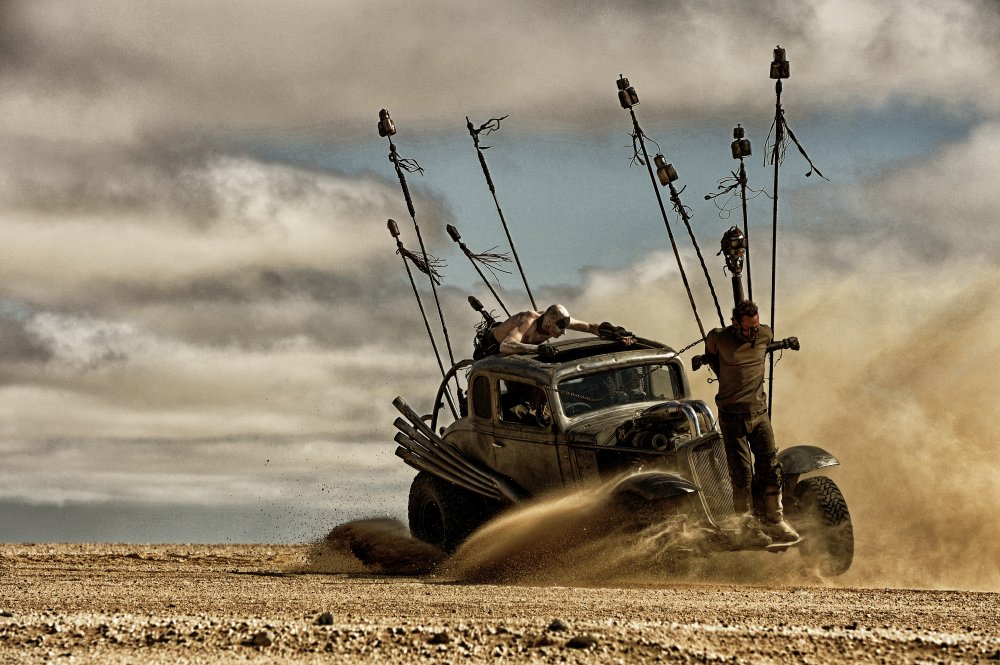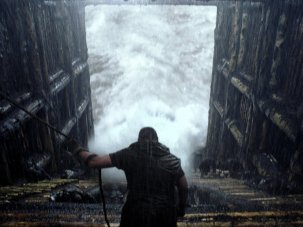“Those guys wouldn’t have been champion when I was around,” Mike Tyson once said, looking over the men who’d held the heavyweight belt during his prison stint. “I went away… and that made them competitive for a time.”
Australia/USA 2015
Certificate 15 120m approx
Director George Miller
Cast
Max Rockatansky Tom Hardy
Imperator Furiosa Charlize Theron
Nux Nicholas Hoult
Immortan Joe Hugh Keays-Byrne
The Splendid Angharad Rosie Huntington-whiteley
Capable Riley Keough
Toast the Knowing Zoë Kravitz
The Dag Abbey Lee
Cheedo the Fragile Courtney Eaton
Slit Josh Helman
Rictus Erectus Nathan Jones
Dolby Digital
In Colour
[2.35:1]
UK release date 15 May 2015
Distributor Warner Bros
warnerbros.co.uk/movies/mad-max-fury-road
► Trailer
George Miller, who made his directorial debut with 1979’s exemplar of vehicular action Mad Max, hasn’t been in the cooler like Tyson (or John McTiernan), but recently he has concerned himself with franchises involving talking pigs (Babe) and soft-shoeing penguins (Happy Feet). In the 30 years since Mad Max Beyond Thunderdome, a number of champs have come and gone, and the car chase has become a game of featherlight pixels floating about. Now the wait is over, and the weight is back.
Miller’s Mad Max: Fury Road is a hammer-down, cast-iron-plated, diesel-exhaust-belching manifesto on the physics of screen action, a metamechanics monster truck show with everything but a Robosaurus. It is something like the rundown in the last third of Mad Max 2 (1981) stretched to feature length – I don’t believe I have seen a film on this scale so single-mindedly dedicated to the heat of pursuit since, well, Mel Gibson’s Apocalypto (2006).
The man the tabloids have dubbed Mad Mel has been deemed unsafe-at-any-speed for a franchise property, so the role of Max Rockatansky has now gone to sensitive silverback Tom Hardy. It’s a downgrade – though it would be misleading to suggest that Hardy is being asked to ‘carry’ the movie. His Max spends much of Fury Road being jerked hither and thither by forces beyond his command, first picked up by the corpsepaint-pallid ‘War Boy’ soldiers serving water-hoarding dictator King Immortan Joe (Hugh Keays-Byrne, Mad Max’s main heavy, unrecognisable beneath oxygen-mask headgear), then throwing in his lot with renegade Imperator Furiosa (Charlize Theron, sporting a prosthetic arm), who’s made off with one of Joe’s armoured trucks and his five-woman harem, driving headlong into the arid wasteland with three armies at her heels.

Mad Max Fury Road (2015)
From humble, homemade origins, each Max movie has trebled in size, and Fury Road is the metastasised endpoint. Miller is making an epic, and has chosen his visual references accordingly: Joe’s ‘Citadel’ reproduces the high and low strata of Lang’s Metropolis (1927), while the flight across the desert, replete with a sandstorm whipped up by a freak cyclone, evokes the Old Testament shock and awe that evaded Ridley Scott’s Exodus: Gods and Kings.
Shot in the Namib Desert of south-west Africa by DP John Seale, Fury Road has a palette that’s all ochre by day, cobalt by night. It seems that the eco-crisis which has scorched the earth has brought with it an infertility epidemic, but we are given to understand only as much of the actual mechanics of the society that has emerged since “the world fell” as we can glimpse in the rear-view. The camera is almost perpetually in motion, and when it isn’t, everything else is; the dialogue, mostly shouted, is half-heard over the roar of a V8 engine.
This isn’t haphazard storytelling: Miller knows that stopping off for exposition breaks will cost him valuable speed. Max, Furiosa and the others speak of their world – or rather don’t speak of it – as people who are accustomed to living in it might, and save their breath for matters of practical exigency, which is to say survival. How do you steer without a wheel? Use a wrench! How do you free yourself of harpoons in the rear end of your truck? Get back there with a bolt-cutter! How do you keep a commandeered vehicle moving when you’re about to abandon ship? Use the huge, gouty foot of an obese, recently deceased steampunk J.P. Morgan with an ornate false nose and holes in his waistcoat to accommodate his chained nipple rings!

Mad Max Fury Road (2015)
It is a movie of split-second decisions, cut-the-crap materialistic down to the very last particular, where every bullet in a clip (and the one in the chamber) and every centimetre of leeway counts, as in a startling moment where Max saves his skull by catching a crossbow bolt in the meat of his palm, one of several score of gasp-inducing details. Given that the aesthetic of the Mad Max franchise has influenced visual culture every bit as much as that of Metropolis or Blade Runner (1982), from 2Pac’s California Love music video to the Fallout game series to every post-apocalyptic film to come in its wake (including recent Aussie entry The Rover), it is remarkable that Fury Road manages to be at once familiar and yet consistently surprising, not to say astonishing.
Moments of ooh-aahh ingenuity include bomb-tossing dirt bikers being target-shot from the sky like clay pigeons, gymnastic ‘polecats’ swooping in from tall, limber staffs on fulcrums, and an armada of vehicles sprung from the minds of madly inspired chop-shop Frankensteins, each one reduced to its constituent parts in turn, accompanied by awesome through-the-windshield acrobatics by vanquished custom-car commandos. Miller even has the confidence to elide one major set piece, rendering carnage as faint orange flash in the fog, and a distant flapping of crows. So, in the presence of the real deal, shall bloviated franchises and committee blockbusters scatter to the wind.
-
Sight & Sound: the July 2015 issue

The Other Side of Orson Welles, plus Amy, The Look of Silence, The Misfits, the best of Cannes and the S&S Interview with John Boorman.
-
The Digital Edition and Archive quick link
Log in here to your digital edition and archive subscription, take a look at the packages on offer and buy a subscription.










